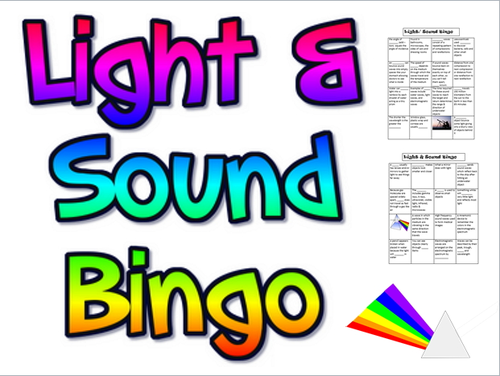

Save time, increase student interest and review related vocabulary with this bingo game. Full version includes multiple clues for each concept and 25 total bingo cards. No two bingo cards are alike. Each card contains a statement, definition, example, graphic or fill-in-the-blank which corresponds to a clue.
Includes transverse and compression waves, telescopes, microscopes, refraction, reflection, opaque, transparent, translucent, ultrasound, sonar, electromagnetic spectrum, amplitude, wavelength, frequency, concave/convex lenses and more. Markers include graphics which help students visualize concepts.
To make long lasting cards, run on card stock and laminate. It is easy to add in your own clues or even use student generated clues, worksheets or workbooks for additional clues.
Teacher can choose which cards and clues for specific topics or use all the cards for review or introducing a unit to assess student background knowledge.
DIFFERENTIATION NOTE: Card titles vary slightly so the teacher can differentiate instruction by level of difficulty. See directions for a full explanation.
Teaching suggestion: Have students silently or with a partner read over their cards before beginning and allow them to ask questions before starting. Teacher reads the marker chip and students must find their corresponding marker and place it on the appropriate spot. Allow students to mark any square/spot/answer that fits the marker. Some cards contain pictures which might fit multiple concepts. Base your acceptance on their rationale. (The pictures match is not a good rationale.)
When a student has 4 in a row and calls bingo, they must read aloud the marker and square chosen. If they are correct, they win. Clear cards, trade cards (teacher's choice) and play again. If they are incorrect, the first student who raises their hand and corrects the mistake gets to cover any square of their choice as a bonus (promotes listening). Game continues.
Includes transverse and compression waves, telescopes, microscopes, refraction, reflection, opaque, transparent, translucent, ultrasound, sonar, electromagnetic spectrum, amplitude, wavelength, frequency, concave/convex lenses and more. Markers include graphics which help students visualize concepts.
To make long lasting cards, run on card stock and laminate. It is easy to add in your own clues or even use student generated clues, worksheets or workbooks for additional clues.
Teacher can choose which cards and clues for specific topics or use all the cards for review or introducing a unit to assess student background knowledge.
DIFFERENTIATION NOTE: Card titles vary slightly so the teacher can differentiate instruction by level of difficulty. See directions for a full explanation.
Teaching suggestion: Have students silently or with a partner read over their cards before beginning and allow them to ask questions before starting. Teacher reads the marker chip and students must find their corresponding marker and place it on the appropriate spot. Allow students to mark any square/spot/answer that fits the marker. Some cards contain pictures which might fit multiple concepts. Base your acceptance on their rationale. (The pictures match is not a good rationale.)
When a student has 4 in a row and calls bingo, they must read aloud the marker and square chosen. If they are correct, they win. Clear cards, trade cards (teacher's choice) and play again. If they are incorrect, the first student who raises their hand and corrects the mistake gets to cover any square of their choice as a bonus (promotes listening). Game continues.
Something went wrong, please try again later.
This resource hasn't been reviewed yet
To ensure quality for our reviews, only customers who have purchased this resource can review it
Report this resourceto let us know if it violates our terms and conditions.
Our customer service team will review your report and will be in touch.
$3.00
